Panang curry is one of my all time favourite Thai curries, especially for a busy weeknight, because it's so quick and simple to make. While you may be able to buy store bought panang curry paste, it always tastes better from scratch! I will also provide you with a "hack" for making a quicker semi-homemade version as well!
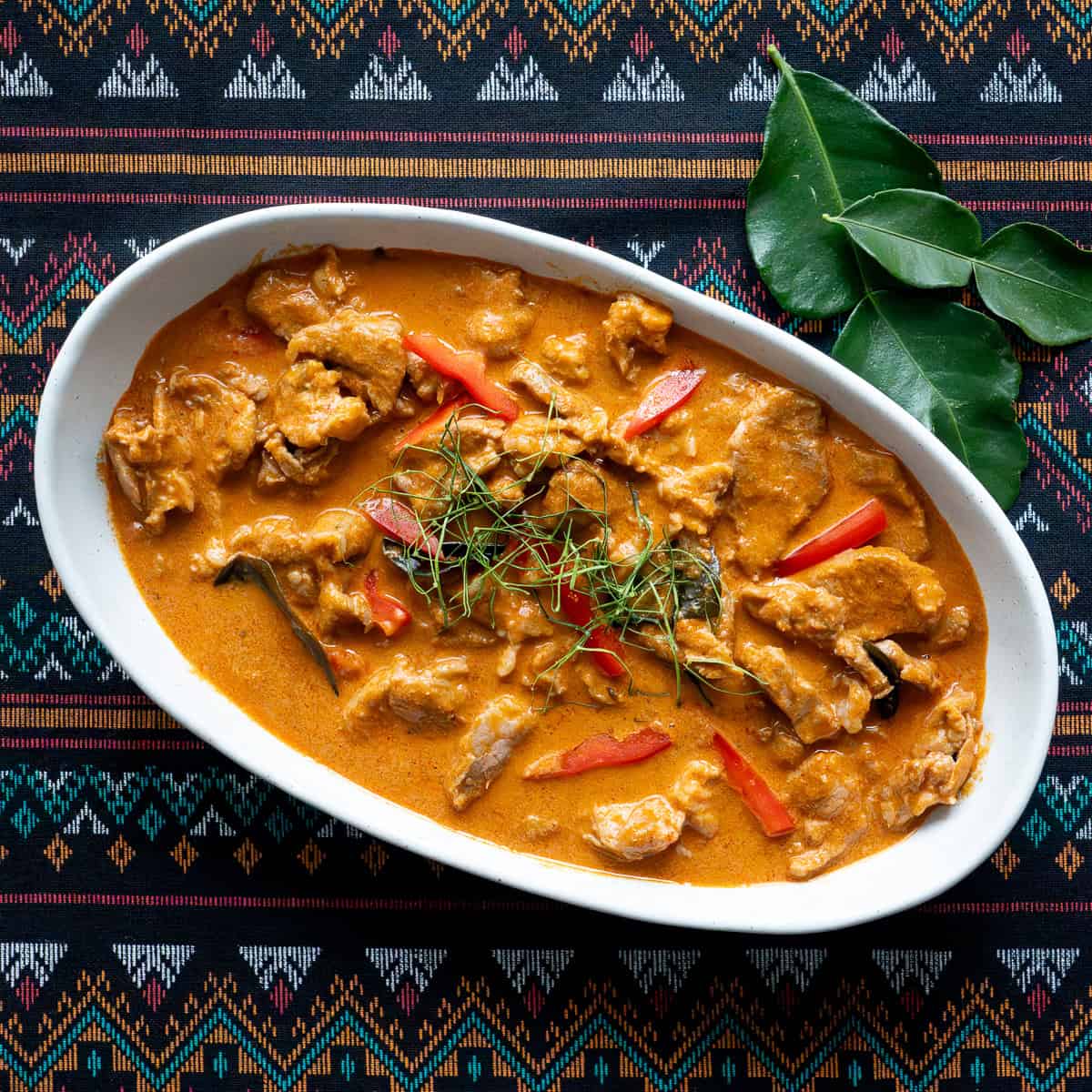
Want to save this recipe?
Ingredients and Notes
Here are all the ingredients you'll need to make panang curry paste from scratch and important notes about them. For amounts, check out the full recipe card below, and don't forget to check out the quicker semi-homemade version as well!
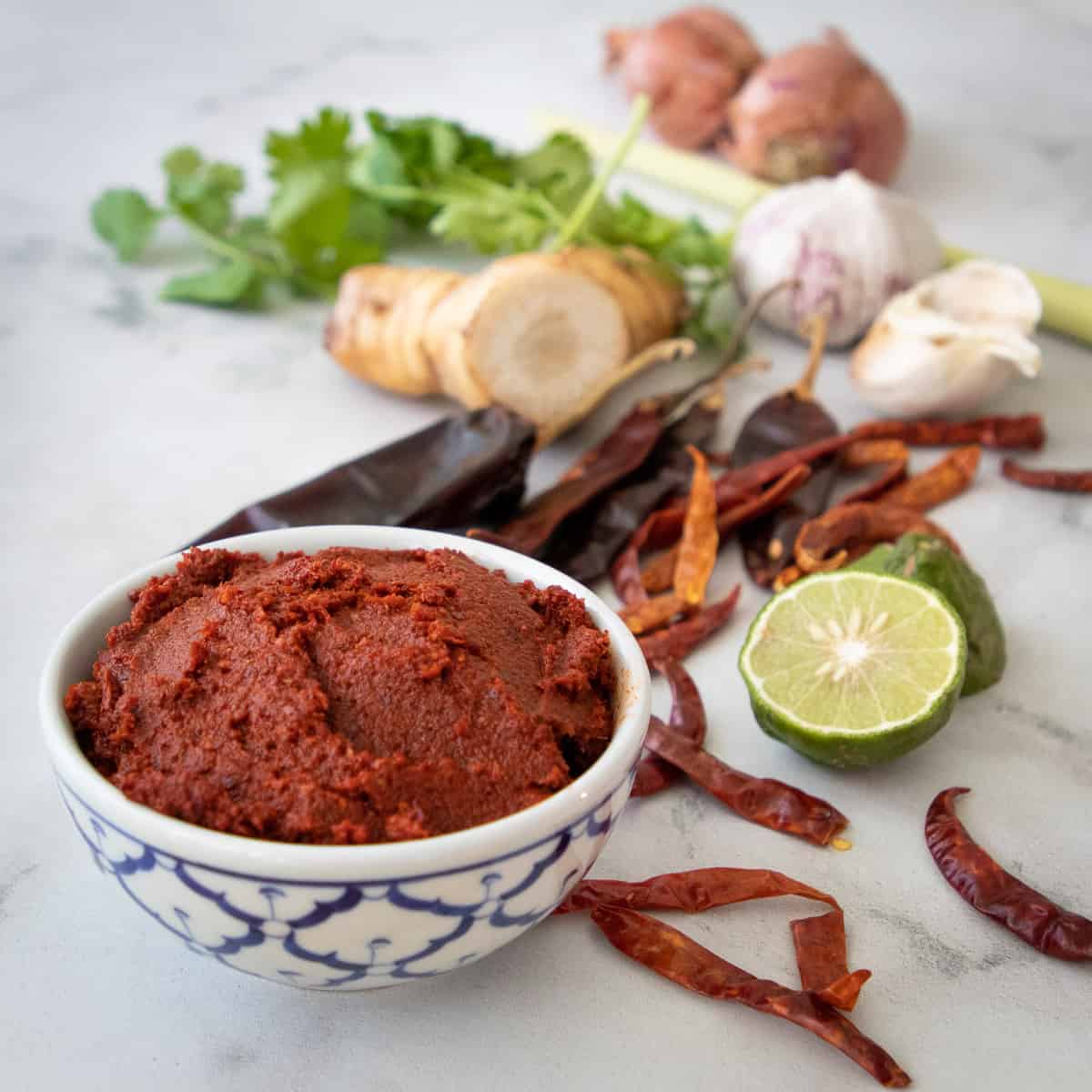
- Dried Chilies: Panang curry is typically mild, so I usually go for gentler dried chilies like guajillo or puya. If you prefer more heat, feel free to mix in some spicier ones like Thai or arbol chilies.
- Coarse Salt: Coarseness is helpful if you're grinding the paste by hand since it adds abrasion, but if you’re using a food processor or blender, any salt will work just fine.
- Toasted Cumin Seeds. Cumin and coriander are two key ingredients. that distinguishes panang curry paste from red curry paste.
- Toasted Coriander Seeds. Always use coriander seeds and never ground coriander as whole seeds are so much more aromatic.
- White Peppercorns.
- Chopped Lemongrass: Use only the bottom portion of the stalk where the flavor is strongest. (Learn more about lemongrass here.)
- Chopped Galangal: Both fresh and frozen galangal are fine. (More info on galangal here.)
- Makrut Lime Zest: Also known as kaffir lime zest, this comes from the green peel of makrut limes. It's not always easy to source, but no stress—just toss in a few extra makrut lime leaves when you make the curry as the leaves and zest have the same aroma. (More on makrut lime leaves here.)
- Cilantro Roots: These are the roots from the cilantro (or coriander) plant, widely used in Thai cooking. If you can’t find them, cilantro stems make a good substitute.
- Garlic
- Shallots
- Shrimp Paste: Known as gapi in Thai, this fermented paste delivers deep umami flavor. It’s pungent and salty, and while it’s traditionally included, you can leave it out and just add a bit more fish sauce to your curry. For a vegan version, substitute miso paste.
- Roasted Peanuts: Peanuts are the defining ingredients of panang curry paste. They bring a rich, nutty depth to the curry. If you have a peanut allergy, you can replace them with any other nuts or seeds that work for you.
How to Make Panang Curry Paste
Here are all the steps to make panang curry paste. Note that this is my current method that uses a coffee grinder to help with the dry spices which saves a lot of time, and for the quickest way, blend the rest of the paste with a powerful immersion blender. In the video tutorial below, you can see how I make it all manually the traditional way using only a mortar and pestle.
- Using a coffee grinder, grind the dried chilies, coriander, cumin, peppercorns, and salt into a fine powder. Remove and set aside.
- Grind the peanuts in the coffee grinder until fine but not oily.
- If using a heavy-duty mortar and pestle, add the lemongrass, galangal, makrut lime zest and cilantro roots; pound into a fine paste. Add the shallots and garlic, and pound into a fine paste. Add the ground chili mixture and the peanuts; pound until well combined.
- If using an immersion blender, place the lemongrass, galangal, makrut lime zest and cilantro roots in a narrow container, such as a glass measuring cup. Top it off with the shallots and garlic (it is easier to blend with the moister ingredients on top ).
- Use the immersion blender to blend everything until fine. You will need to lift and reposition the blender several times, stopping to scrape the bottom and bringing it to the top halfway through. Once the mixture is fine, add the ground chili mixture and the peanuts and blend to mix.
- Use right away, store in the fridge for up to 3 days, or freeze for up to a few months.
Watch The Full Video Tutorial!
This is the video where I showed how to make panang curry paste the traditional way, entirely manually using a mortar and pestle. You can also watch this video on my YouTube channel. For an updated tutorial on curry paste making that shows how to use grinders and blenders to make it go faster, see my red curry paste recipe.
Hack: Semi-Homemade Panang Curry Paste
If you're not able to make panang curry paste from scratch, and you can't find pre-made paste at the store, there is a hack! You can use store bought red curry paste, which is widely available, and turn it into panang curry paste simply by adding a few things. Thai red curry paste is essentially our "basic" paste upon which other pastes are built!
Here are the ingredients you'll need to turn store bought red curry paste into panang paste!
- Red curry paste, I recommend Maeploy, Aroy D or Namjai brands. Blue Elephant is also good for those in the UK. Do not use Thai Kitchen as it is very weak.
- Toasted cumin seeds.
- Toasted coriander seeds.
- Roasted peanuts, if allergic, you can sub another type of nuts or seeds that you can eat.
- Fermented shrimp paste, this is optional, and if your red curry paste already contains shrimp paste (check the ingredient list) you don't need to add more.
All you have to do is grind the spices ad the peanuts and combine everything together. See amounts in the recipe card below!
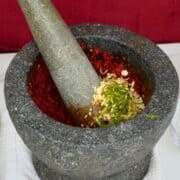
Thai Panang Curry Paste
- Total Time: 25-40 mins, depending on method
- Yield: Enough for 3-4 servings of panang curry
- Cuisine: Thai
Description
Take your panang curry to the next level with homemade panang curry paste!
Ingredients
Want to save this recipe?
- 10 g mild dried chilies, such as guajillo or puya (see note)
- ½ tsp salt
- ¾ tsp cumin seeds, toasted
- 1 ½ tsp coriander seeds, toasted
- ¼ tsp white peppercorns
- 2 inches lemongrass from bottom half, sliced into very thin rounds
- 1 Tbsp (15 ml) finely chopped galangal
- 1 ½ tsp (7.5 ml) finely chopped makrut lime zest
- 2 cilantro roots or 6 cilantro stems, finely chopped
- 3 Tbsp (45 ml) finely chopped garlic
- ¼ cup (60 ml) finely chopped shallots
- 1 tsp (5 ml) fermented shrimp paste
- 12-15 roasted peanuts
Option 2: Semi-Homemade Panang Curry Paste
- 4 tablespoons red curry paste (see brand recommendations in the blog post above)
- ¾ tsp cumin seeds
- 1 ½ tsp coriander seeds
- 12-15 roasted peanuts
- 1 tsp (5 ml) fermented shrimp paste (optional, only if the red curry paste doesn’t already have it)
Instructions
Note: The methods below is my updated method that I currently use. For an all-manual method using only a mortar and pestle, see the video tutorial.
- Using a coffee grinder, grind the dried chilies, coriander, cumin, peppercorns, and salt into a fine powder. Remove and set aside.
- In the same grinder, grind the peanuts until fine but not oily.
- If using a heavy-duty mortar and pestle, add the lemongrass, galangal, makrut lime zest and cilantro roots; pound into a fine paste. Add the shallots and garlic, and pound into a fine paste. Add the ground chili mixture and the peanuts; pound until well combined.
- If using an immersion blender (best if making a double batch otherwise there may not be enough volume to properly grind), place the lemongrass, galangal, makrut lime zest and cilantro roots in a narrow container, such as a glass measuring cup. Top it off with the shallots and garlic (it is easier to blend with the moister ingredients on top ). Use the immersion blender to blend everything until fine. You will need to lift and reposition the blender several times, stopping to scrape the bottom and bringing it to the top halfway through. Once the mixture is fine, add the ground chili mixture and the peanuts and blend to mix.
- Use right away, store in the fridge for up to 3 days, or freeze for up to a few months.
For Semi-Homemade Panang Curry Paste
- Grind the cumin and coriander seeds until very fine using a mortar and pestle or a coffee grinder. Remove and set aside.
- Add the roasted peanuts to the grinder or mortar and pestle and grind until fine but not oily.
- Mix ground spices into the red curry paste and shrimp paste, if using a mortar and pestle, simply pound to mix.
Notes
Panang curry is typically not very spicy, but if you want to make it spicy, add some spicier dried chilies such as arbol or Thai chilies in addition to the mild ones.


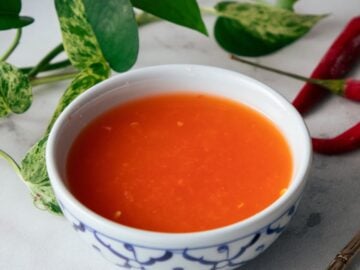

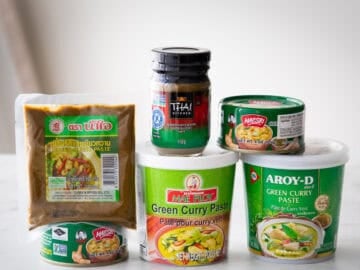

Michelle Chak says
How much paste is required to cook a whole chicken in pieces, please?
Ann U. says
Because I live where it's hard to get many thai ingredients, I'd like to try and just add the 3 ingredients you mention to purchased red curry paste. How much should coriander, cumin seed and peanuts should I add to a 400g package of store bought red curry?
Jethro says
Another gorgeous recipe! I've been teaching myself to cook and your recipes never miss!
I was wondering if the paste can be frozen? Or would that lose some of the flavour?
Pailin Chongchitnant says
THank you! And yes absolutely the paste can be frozen.
Gayatri says
If I were to make this with an immersion blender, should I do it the way you've done your gaeng hung lay curry paste? (Don't rehydrate the chilies instead grind them into a powder along with the pepper, cumin and coriander seeds . Add everything else but the peanuts into the blender and make a paste. Then add the chilli powder and spices and blend again. Finally adding the peanuts and blending?)
Pailin Chongchitnant says
Correct! Except you can add the peanuts along with the garlic and shallots as you'll want it to be ground quite finely.
Steph says
This was fantastic, will definitely make it again. I'll probably scale back the chilli a little to suit my wimp level heat preference.
The coriander roots were the trickiest thing to source; I resorted to snipping them from the contents of a tub of growing coriander from the supermarket, and they were tiny. Is there anything I could substitute for these?
Pailin Chongchitnant says
Glad to hear, than you! You can also use the stems of cilantro and it will work also 🙂
Jason R says
Is there a substitute for the kaffir lime zest? I am able to find the leaves but not the limes?
Pailin Chongchitnant says
Hi! You can just omit it from the paste and then add a few extra leaves when you make the curry itself 🙂 You can also substitute regular lime zest but it does have a different aroma.
Jason R says
Thank you so much for the reply. One other question if you have time. I cannot find spur chilis fresh or dry in Seattle. We have fresh Fresno, Birds Eye and Korean long chilis and standard Mexican dried chilis along with Chinese dried chilis. Could fresh Fresno/Korean be used in this or do you have a Mexican chili substitute you suggest using?
colin says
What kind of dried peppers are those? Would arbol chiles work?
Adam The HTK Minion says
Hi Colin! They are spur chilies, arbol is a bit spicy so would remove seeds.
Davi-lee says
Hi, I was wondering if any one knows how much curry paste this makes?
Pailin Chongchitnant says
This makes about 5 Tbsp, enough for one recipe of the panang curry recipe on the site.
Yuko says
My kids have peanut allergy. What can I use to substitute?
Pailin Chongchitnant says
You can use some white beans or another kind of nut they have have, it's just added for extra richness and thickness. You can also omit it altogether.
K says
I did not expect the bicep work out I got with this recipe lol
Blaire says
Incredible!!! I made this last night - insanely delicious!! Perfect balance. I plan to make a large batch to have on hand—we want more. How long does the curry paste last in the fridge and maintain the flavor?
I made with prawns and pumpkin, sourced the specific brands listed for all items in the paste and final product (coconut milk in paper box, fish sauce with lady in boat, etc). Best curry I’ve ever made and probably ever had. Thanks!! I will be making
all of your recipes now!!